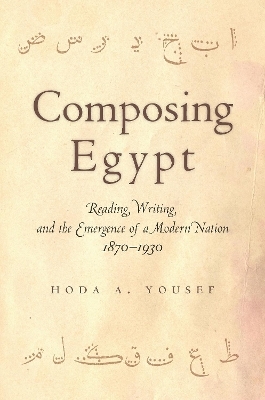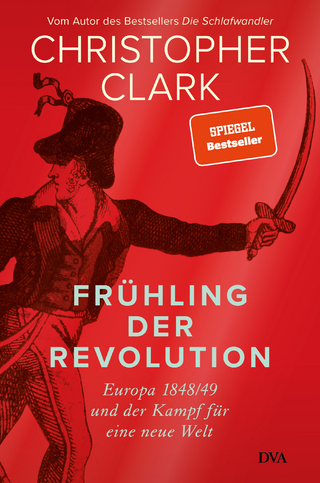
Composing Egypt
Stanford University Press (Verlag)
978-0-8047-9711-5 (ISBN)
In this innovative history of reading and writing, Hoda Yousef explores how the idea of literacy and its practices fundamentally altered the social fabric of Egypt at the turn of the twentieth century. She traces how nationalists, Islamic modernists, bureaucrats, journalists, and early feminists sought to reform reading habits, writing styles, and the Arabic language itself in their hopes that the right kind of literacy practices would create the right kind of Egyptians.
The impact of new reading and writing practices went well beyond the elites and the newly literate of Egyptian society, and this book reveals the increasingly ubiquitous reading and writing practices of literate, illiterate, and semi-literate Egyptians alike. Students who wrote petitions, women who frequented scribes, and communities who gathered to hear a newspaper read aloud all used various literacies to participate in social exchanges and civic negotiations regarding the most important issues of their day. Composing Egypt illustrates how reading and writing practices became not only an object of social reform, but also a central medium for public exchange. Wide segments of society could engage with new ideas about nationalism, education, gender, and, ultimately, what it meant to be part of "modern Egypt."
Hoda A. Yousef is Assistant Professor of History at Denison University.
Contents and AbstractsIntroduction: Literacies, Publics, and Gender chapter abstractThis chapter introduces the idea of gendered public literacies; that is, broad-based literacies that changed the contours of public spaces and had lasting implications for gendered uses of literacy. These three lenses are central to the process of unpacking the influence of Arabic language reforms, women's roles in public life, protests and activism, and education among a broader segment of Egyptians—not just among the educated elite. The introduction also details the sources and methodology of this study and provides some historical background on Egypt during this period.
1The Discourse and Practice of Everyday Literacies chapter abstractThis chapter surveys how literacies were talked about and used between 1860 and 1930. Over this period, the idea of literacy was becoming more reified as a social ideal that represented progress, advancement, and optimism, particularly for those invested in the idea of a modern Egypt: nationalists, women activists, and bureaucrats, as well as Coptic and Muslim reformers. Those already educated were encouraged to participate in ever more beneficial forms of literacy, and the visibility of literacies—in life, print, and politics—made it central to what it meant to be engaged in the social issues of the day. Meanwhile, practices of literacies were diversifying and reaching more people across the educational spectrum, particularly through the press and the postal system. Egyptians who were not "officially" literate were able to engage in communal practices of reading aloud, letter writing, and the like, to a quantitatively and qualitatively new extent.
2Literacies of Exclusion: Mistresses of the Pen chapter abstractThis chapter examines the exclusions created by gendered literacies that mediated both participation in and visibility to various publics, often along class lines. Despite the noble rhetoric of literacy promotion, reading and writing were each associated with different kinds of public interactions and, ultimately, societal hazards. To consume potentially dangerous texts or become "visible" through the written word was associated with disruptive social and economic consequences for historically unlettered segments of Egyptian society. Nevertheless, several female writers active in the early Egyptian feminist movement sought to access these visible publics through writing and, in the process, renegotiated and redefined this transgression as a complement to their domestic roles. Just as they could be modern, respectable, and productive "mistresses of the home," they would now become "mistresses of the pen."
3Writing for the Public: Schooled Literacies chapter abstractThis chapter looks at the shift that was occurring in and beyond schools regarding the nature of Arabic literacy and the profession, and skills associated with "writers" in the era of the Arab naha, or renaissance. By looking at not only education itself, but also how the very fabric of instruction was designed, executed, and ultimately deployed, this chapter shows that both "modern" and the more ubiquitous "traditional" schools were introducing fundamental changes to how they taught Arabic language. Various schools were emphasizing "practical" instruction, structuring lessons and exams around the skill of composition, and training students how to think, read, and write about their society. The humble school composition (inshā) became a practical exercise in the art of social commentary, reinforcing certain types of interactions through the written word in communal life.
4Writing to Be Seen and Heard: Petitions and Protests chapter abstractThis chapter examines how new literacies impacted the protest and petitioning movements of the early twentieth century. Older forms of communication and writing were adapted to the changing discourses and technologies of the era as individuals and groups sought to channel discussions on nationalism, education, and Egyptian-ness to press their cases and attempt to influence the official course of Egyptian politics. The chapter culminates in the events and aftermath of the 1919 revolution in Egypt, when many of the new technologies of public literacies were deployed by various segments of the Egyptian populace in their attempt to throw off the yoke of the British Protectorate. Ultimately, though many people engaged with these literacies, written forums also imposed their own unevenness, as access to printers and more expensive "modern" forms of literacy determined who could be "seen" in the public spaces of literary production.
5Literacy for All: Ummiyya, Arabic, and the Public Good chapter abstractThis chapter explores the impact and implications of public literacies, particularly as the concept of illiteracyevolved from a term with positive connotations to one associated with social backwardness and underdevelopment. Specifically, apprehension about illiteracy as an important measure of social progress found expression and visibility in publicized census literacy rates that depreciated "alternative" literacies in favor of a defined and measurable skill. This change was strikingly manifested in the growing concerns of the 1920s about the social danger of illiteracy and in the first real government attempt to eradicate illiteracy from the population. By 1924, basic education was enshrined as an aspiration of the first Egyptian Constitution and the groundwork for a true mass educational system was laid. However, this narrow, utilitarian, and measurable definition of literacy also created exclusions for blind students, those who used the Egyptian colloquial, and other Egyptians who were not conventionally "literate."
Conclusion: Literacy and Literacies chapter abstractThe conclusion recaps the major argument of this work: that literacies, as a broad set of practices, were in wide use over this period even as the idea of a narrow concept of literacy became central to the idea of modern Egypt. It also provides some examples of how literacy campaigns and literacy rates continue to be an important source of public concern. With the emergence of electronic media, digital forms of reading and writing have taken on new import, particularly in light of the recent events of the Arab Uprising/Arab Spring.
| Erscheinungsdatum | 07.07.2016 |
|---|---|
| Verlagsort | Palo Alto |
| Sprache | englisch |
| Maße | 152 x 229 mm |
| Themenwelt | Sachbuch/Ratgeber ► Geschichte / Politik ► Allgemeines / Lexika |
| Geschichte ► Allgemeine Geschichte ► Neuzeit (bis 1918) | |
| Geisteswissenschaften ► Geschichte ► Regional- / Ländergeschichte | |
| Geschichte ► Teilgebiete der Geschichte ► Kulturgeschichte | |
| ISBN-10 | 0-8047-9711-0 / 0804797110 |
| ISBN-13 | 978-0-8047-9711-5 / 9780804797115 |
| Zustand | Neuware |
| Haben Sie eine Frage zum Produkt? |
aus dem Bereich


